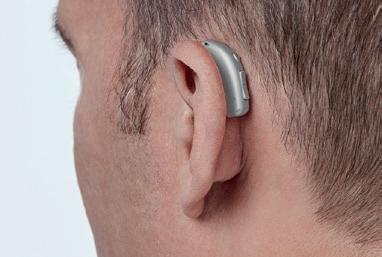
2 minute read
DEVELOPING TECHNOLOGIES TO PROMOTE BRAIN HEALTH
Developing Technologies to
PROMOTE BRAIN HEALTH
New scientific discoveries are helping us better understand the way we hear. Research has shown us that the brain needs access to all sounds, not just speech, to function naturally.
Recent studies1,2 have used brain imaging techniques to show that sounds are interpreted by two subsystems in the brain: the orient subsystem and the focus subsystem. Together, they allow people to understand and locate all of the sounds around them (orient) and determine which sounds to listen to (focus). However, in order to work this way, our brain needs to receive a good neural code— information transmitted by the auditory nerve in the cochlea (a peripheral hearing organ) to the auditory cortex in the brain. It’s what allows the brain to make sense of what we hear, which in turn lets us recognize and remember sounds more easily. When a person has hearing loss, the neural code starts to break down. As a result, our brain doesn’t process the information as well, since hearing requires more listening effort and mental workload.3 All of this can accelerate cognitive decline, especially our ability to remember, learn, concentrate, and make decisions.4 All of these conclusions have led hearing health professionals to change their views on programming hearing aids. Limiting access to certain sounds, as conventional hearing aids often do, simply isn’t an option. Instead, hearing aids now provide a good neural code. One hearing aids manufacturer has developed a new approach to digital sound processing— one that aims to support the natural hearing process by giving wearers access to the full sound scene. Not only does this approach help people with hearing loss understand the world around them, it also helps preserve their brain function.
If you have any questions, don’t hesitate to get in touch with your audioprosthetist!

Neural code: information transmitted by the auditory nerve in the cochlea (a peripheral hearing organ) to the auditory cortex in the brain. What
IS IT?
An assessment by an audioprosthetist is required to determine which hearing aid suits the patient’s needs.
Charles-Edouard Basile
Business Development Manager
References 1. O’Sullivan, J., Herrero, J., Smith, E., Schevon, C., McKhann, G. M., Sheth, S. A.,
Mesgarani, N. (2019). Hierarchical Encoding of Attended Auditory Objects in Multi-
Talker Speech Perception. Neuron, 104(6), 1195-1209. e1193. 2. Puvvada, K. C., & Simon, J. Z. (2017). Cortical Representations of Speech in a
Multitalker Auditory Scene. Journal of Neuroscience, 37(38), 9189-9196. 3. Pichora-Fuller, M. K., Kramer, S. E., Eckert, M. A., Edwards, B., Hornsby, B. W.,
Humes, L. E., Mackersie, C. L. (2016). Hearing Impairment and Cognitive Energy:
The Framework for Understanding Effortful Listening (FUEL). Ear and hearing, 37, 5S-27S. 4. Uchida, Y., Sugiura, S., Nishita, Y., Saji, N., Sone, M., & Ueda, H. (2019). Age-
Related Hearing Loss and Cognitive Decline – The Potential Mechanisms Linking the
Two. Auris Nasus Larynx, 46(1), 1-9.







